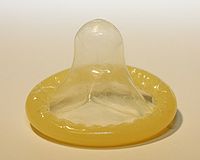- Contraception
-
Contraception is the prevention of the fusion of gametes during or after sexual activity. The term contraception is a contraction of contra, which means against, and the word conception, meaning fertilization.[1] Contraception can occur both naturally and via artificial means in humans and in animals.
Contents
Human contraception
Contraception can occur both naturally and via artificial means in humans.
Naturally occurring contraception
When a mother feeds her baby only with her breast milk, this might possibly prevent the release of hormones which cause ovulation [2] This occurs naturally, but it can also be manipulated as a method of birth control called the Lactational amenorrhea method.
Contraception as a form of birth control
The techniques of birth control can be classified by the stage of reproduction during which it is active. A form of birth control which prevents the sperm from fertilizing the egg is a contraceptive agent.[3][4] A form of birth control which acts after fertilization to prevent or interrupt the implantation of the embryo into the uterine lining is a contragestive agent.[5] After implantation has occurred, an agent which ends gestation by terminating the pregnancy is an abortifacient.[6][7] These mechanisms of action are not always mutually exclusive. One substance or device can have more than one potential effect depending upon when it is used. For example, while mifepristone is best known as an abortifacient, it can also function as a contragestive agent.[8] Likewise, the IUD can be used as a contraceptive or a contragestive depending upon when it is inserted.[9]
All contraception methods, other than the use of a condom, are applied by the female. There are a variety of laws in many countries which prohibit or regulate the availability of contraceptive devices. The laws range from outright prohibition to prohibition of some forms of contraception, to minimum ages for availability, to whether a prescription is required, etc.
Contraceptives are devices, techniques and methods used to prevent fertilization. Barrier contraceptives are devices which attempt to prevent pregnancy by physically preventing sperm from entering the uterus. Devices in common use include condoms, female condoms, cervical caps, and diaphragms. SILCS diaphragms are still in clinical testing. Hormonal contraceptives inhibit female ovulation or fertilization. These include injectable[10] and oral contraceptives. The most common hormonal contraceptives are the combined oral contraceptive pill, commonly referred as "The Pill", which includes a combination of an estrogen and a progestin (progestogen), and the minipill that contains only synthetic progestogens and do not contain estrogen.
Emergency contraceptives, or "morning-after pills", are drugs that disrupt ovulation or fertilization in order to prevent pregnancy taken after sexual intercourse. An IUD can also be used as an emergency contraceptive, if it is implanted early enough, although it has a contragestive effect when it is implanted later.[11][12][13]
Contraception in non-human animals
Contraception occurs naturally in non-human animals just as it does in humans. For example the same hormonal effect of breastfeeding occurs both in humans and in chimpanzees [14] Artificial contraception is now being considered as an alternative to hunting as a means of controlling the population of animals which overbreed.[15]
See also
- Abortifacient
- Barrier contraception
- Birth control
- Contragestion
- Hormonal contraception
- Jewish views on contraception
- Male contraceptive
- Reproductive technology
References
- ^ [1] The American Heritage Medical Dictionary Copyright 2007, 2004, page 120.
- ^ [2]The Complete Book of Breastfeeding By Sally Wendkos, Sally Wendkos Olds, Laura Marks, Marvin Eiger Page 57
- ^ [3] Melloni's Pocket Medical Dictionary By June L. Melloni, Ida G. Dox, B. John Melloni, Gilbert M. Eisner, Published by Informa Health Care, 2003, page 86.
- ^ [4] Dorland's Illustrated Medical Dictionary. Philadelphia, PA: Elsevier Health Sciences. (2007). Retrieved May 26, 2009.
- ^ [5] The American Heritage Medical Dictionary, Houghton Mifflin Harcourt; Copyright May 2008. page 124.
- ^ [6] Melloni's Pocket Medical Dictionary By June L. Melloni, Ida G. Dox, B. John Melloni, Gilbert M. Eisner, Published by Informa Health Care, 2003, page 1.
- ^ [7] The American Heritage Medical Dictionary. Boston, MA: Houghton Mifflin. (2007)Retrieved May 26, 2009
- ^ [8]Contragestion and other Clinical Applications of RU 486, an Antiprogesterone at the Receptor, Etienne-Emile Baulieu Science, New Series, Vol. 245, No. 4924 (Sep. 22, 1989), pp. 1351-1357 Published by: American Association for the Advancement of Science Retrieved May 26, 2009.
- ^ [9] Emergency: Emergency Contraception Bobbi J. Morris, Cathy Young, Kathleen Kearney, The American Journal of Nursing, Vol. 100, No. 9 (Sep., 2000), pp. 47 Published by: Lippincott Williams & Wilkins Retrieved May 26, 2009.
- ^ [10]Hendrick, Judith (1997). Legal aspects of child health care. Nelson Thomas. pp. 102. ISBN 9780412583209
- ^ [11]Contragestion and other Clinical Applications of RU 486, an Antiprogesterone at the Receptor, Etienne-Emile Baulieu Science, New Series, Vol. 245, No. 4924 (Sep. 22, 1989), pp. 1351-1357 Published by: American Association for the Advancement of Science Retrieved May 26, 2009.
- ^ [12]Ammer, Christine; Manson, JoAnn E, & Brigham, Elizabeth F. (2009). The Encyclopaedia of Women’s Health. Infobase Publishing. pp. 312. ISBN 9780816074075.
- ^ [13] Emergency: Emergency Contraception Bobbi J. Morris, Cathy Young, Kathleen Kearney, The American Journal of Nursing, Vol. 100, No. 9 (Sep., 2000), pp. 47 Published by: Lippincott Williams & Wilkins Retrieved May 26, 2009.
- ^ [14]The Evolution of human behavior: primate models By Warren G. Kinzey, American Anthropological Association. Meeting, American Association of Physical Anthropologists Page 84
- ^ [15]Popular Science- Birth Control for Animals: A scientific approach to limiting the wildlife population explosion By Rebecca Boyle
Birth control methods (G02B, G03A) Comparison Behavioral Avoiding vaginal intercourse: Abstinence • Anal sex • Masturbation • Non-penetrative sex • Oral sex
Including vaginal intercourse: Breastfeeding infertility (LAM) • Calendar-based methods (rhythm, etc.) • Fertility awareness • WithdrawalBarrier or
spermicidalHormonal
(formulations)Progestogen-onlyAnti-estrogen Ormeloxifene (Centchroman)Post-intercourse Emergency contraception (pills or copper IUD) (Yuzpe regimen, Ulipristal acetate)Intrauterine device Abortion Sterilization Condom Brand names Uses Social issues Condom fatigue · Catholic Church and AIDSHistory Related topics Family planning and reproductive health Rights Education Planning Reproductive life plan · Childfree · Parenting (Childbirth, Adoption, Foster care) · Birth control · Safe sexHealth Pregnancy Medicine Disorder By country Related navboxes {{Birth control methods}} · {{Pregnancy}} · {{Sex}} · {{sexual abuse}} · {{STD/STI}} · {{Assisted reproductive technology}}
Categories:
Wikimedia Foundation. 2010.



